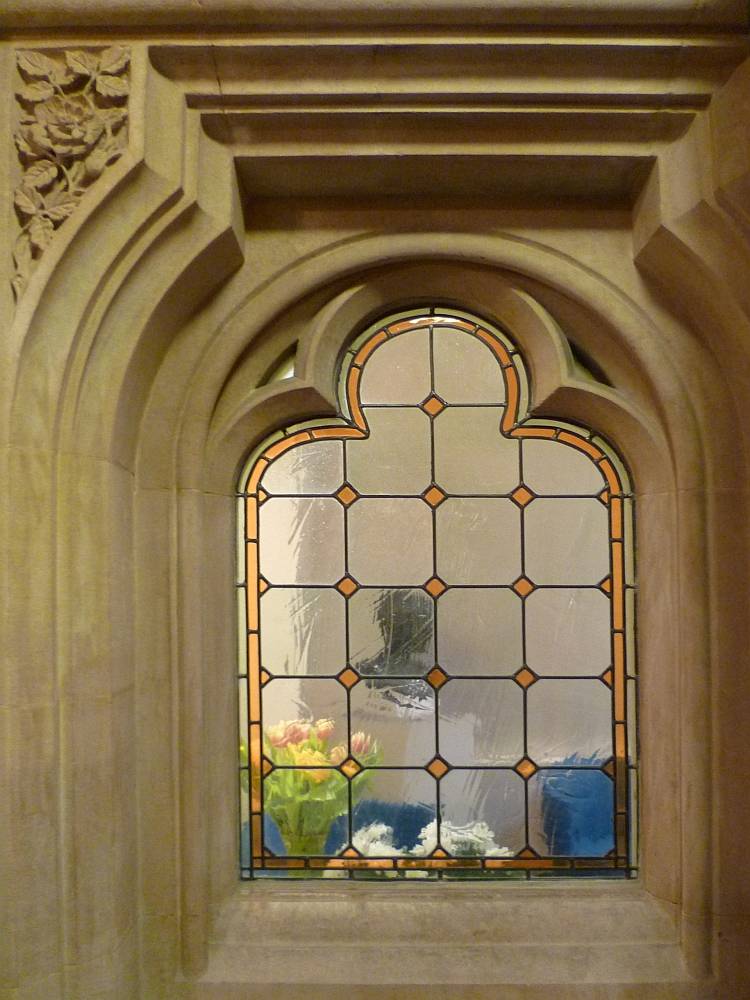[Click on the images for larger pictures. You may use these without prior permission for any scholarly or educational purpose as long as you (1) credit the photographer and (2) link your document to the Victorian Web or cite it in a print one.]
The Apse

St Christopher's Chapel, apse windows, by Clayton & Bell. All the windows in the chapel of Great Ormond Street Hospital for Sick Children, designed by E. M. Barry, are contemporary with the chapel itself and date from 1875 (see Eberhard). They feature children as part of an iconographic scheme encompassing both Old and New Testaments, and are part of the whole decorative project for which Clayton & Bell were responsible. The seven windows here are "set in pointed arch recesses" (listing text) and show the central episodes of the scheme, illustrating the infancy and childhood of Jesus: the Nativity, the Adoration of the Shepherds, the Adoration of the Magi, the Presentation of the child Jesus in the Temple, the flight to Egypt, Jesus with the doctors in the temple, and the Holy Family. Soft toys rest on the ledges below them, left by parents in memory of individual children.

Closer view of the central windows of the apse, showing (left to right) the Adoration of the Magi, the Presentation of the child Jesus in the Temple, and the flight to Egypt. Like the rest of the chapel, the stained glass was "restored to its original condition as far as possible ... under the care of Mr Peter Larkworthy, the consultant conservator and great grandson of Alfred Bell of Clayton and Bell" (Lunnon).
The Body of the Chapel



The windows here too focus on childhood.. Left to right: (a) Jesus called a little child and set him in the midst. In Matthew 18, 2-3, Jesus tells his disciples, "Except ye be converted, and become as little children, ye shall not enter into the kingdom of heaven." As elsewhere in the sequence, Jesus is shown with golden hair. (b) Emmanuel God with us. Eunice, an early believer, teaches her son Timothy about Jesus. The reference in the text is to 1 Matthew, 23: "Behold, a virgin shall be with child, and shall bring forth a son, and they shall call his name Emmanuel, which being interpreted is, God with us" (Matthew 1, 23). Notice the statuette of St Christopher, patron saint of children, and the saint after whom the chapel is named, at the side here. (c) Samuel learns about his faith in the temple: "Samuel grew and the Lord was with him" (1 Samuel 3, 19).


Two details from the windows. Left: Samuel gesturing confidently as he disputes with an elder. Right: A child holds a banner proclaiming, "Hosanna to the Son of God." In this window, as Joan Crossley points out, the golden-haired Jesus is "surrounded by children in medieval dress" (22). The text below the window is from Matthew 21, 16: "Out of the mouths of babes thou has perfected praise."
At the Doors of the Chapel



Left to right: (a) Painted decoration — St Paul stands on one side of the entrance. He holds his usual attributes, the Scriptures to which he himself contributed, and the sword, a reminder of his martyrdom. On the other side of the door, in a matching recess, stands St Peter. (b) An internal window in the entrance area. The use of these elegantly carved recesses brings together harmoniously the work of Barry, as the designer of the chapel, and Clayton & Bell, who decorated it so beautifully. (c) One side of the black ebonized double doors. The elegant foliated metalwork complements the tree-of-life design in the tinted glass panel.
Related Material
- St Christopher's Chapel as a whole (richly decorated throughout by Clayton & Bell)
Sources
Crossley, Joan. Sacred Spaces: The Hospital Chapels of London. London: The Museum of London Archaeology Service, 2005. Print.
Eberhard, Robert."Stained Glass Windows at Great Ormond Street Hospital-Chapel." Church Stained Glass Windows. Web. 19 February 2012.
"Great Ormond Street Chapel in Central Block." British Listed Buildings. Web. 19 February 2012.
Lunnon, Raymond J. The Chapel of St Christopher. NHS Booklet. London: GOS Trust, 2002. Available as a pdf file. Web. 19 February 2012.
Last modified 19 February 2012